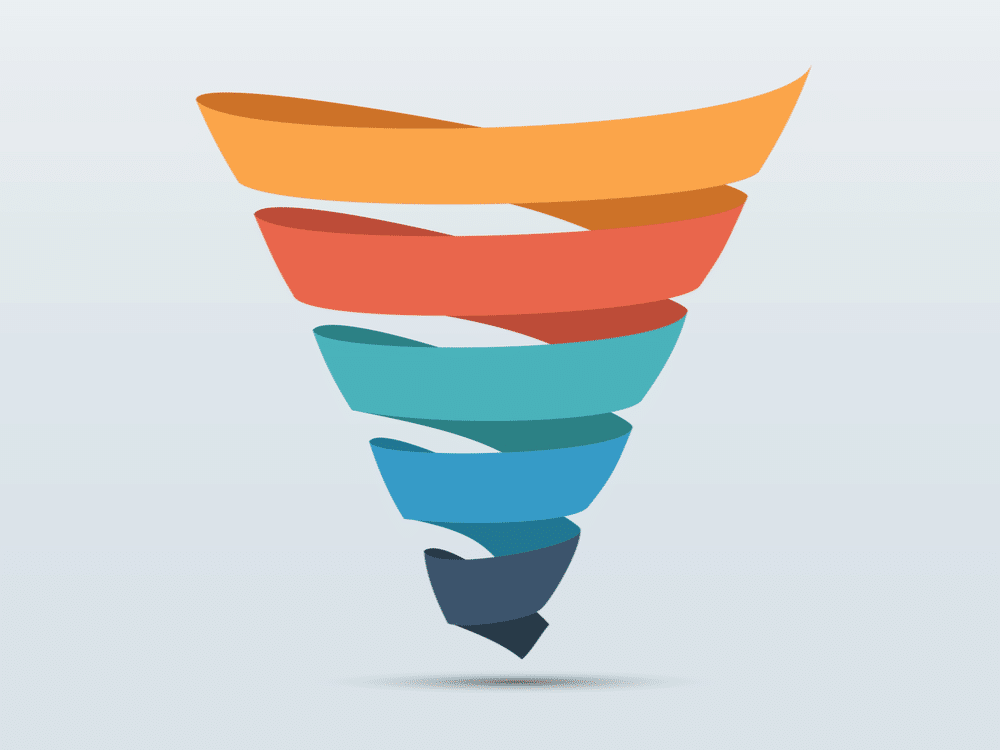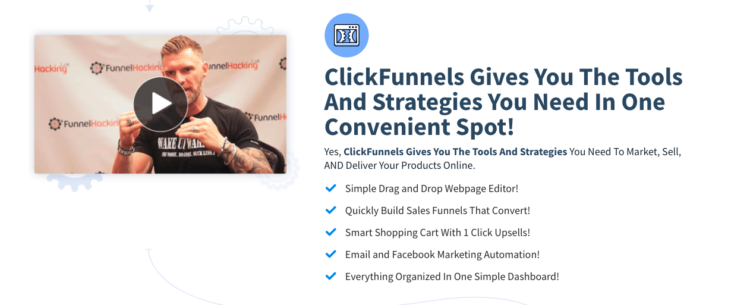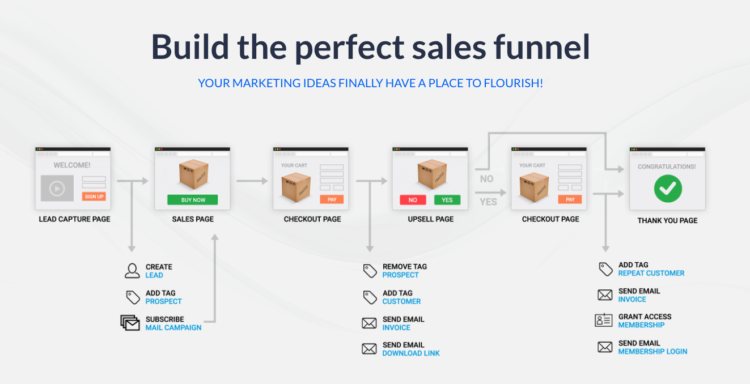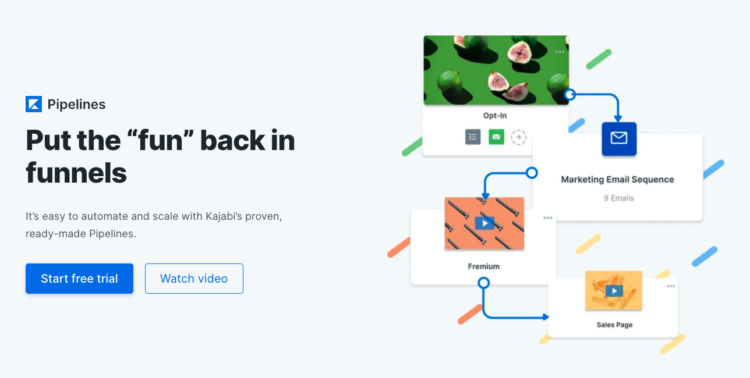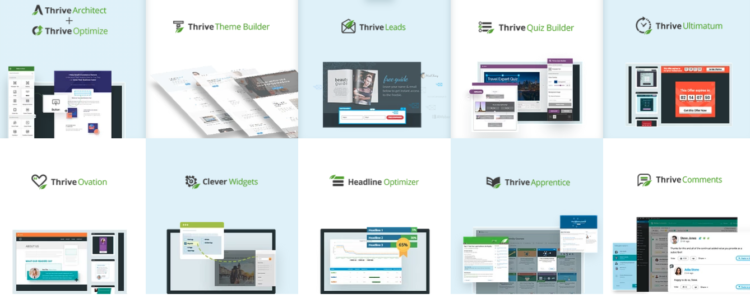Sales funnels are the best thing you can do for your business, so we’ve rounded up the best 5 software tools that will power your business up.
(psst! If you haven’t started looking into sales funnels for your business, this is your cue to get serious about them. Go!)
At the shallow end of the pool, funnels allow businesses to create landing pages quickly, integrate payment gateways in one click, increase average order value with upsells, and remarket to customers with email.
But at the deeper end (and the most important aspect of sales funnels) they help with lead generation or lead gen. In marketing, lead gen is the start of a prospect’s interest in products or services. Using sales funnels means that you can nurture leads on autopilot, and remove human error when it comes to follow-ups. As they say, the fortune is in the follow-up.
The number of touchpoints you need to seal the deal has been estimated to be 8 touchpoints. To get technical for a second, HubSpot has a great summary of touchpoints and why 8 is the magic number:
The law of diminishing returns states that if one production factor (e.g., calls or emails) is increased while other factors are held constant, the output (e.g., open and response rates) will eventually decrease. In other words, a tenth touchpoint is not much more effective than an eighth. With this in mind, eight-touches is a good benchmark number of touchpoints.
To simplify it: you need at least 8 touchpoints and/or follow-ups with a lead to close them.
Sales funnels allow you to do all of this on autopilot. You can track absolutely every interaction your lead/prospect has with you, and watch them reach each touchpoint along the way. You’re not leaving anything up to chance. For ecommerce, it allows you to nurture users through their buyer’s journey, nurture your relationship with customers, and increase average order value (AOV), and lifetime customer value (LTV).
The engine that keeps a sales funnel running smoothly is software. The right software can become a powerful asset for your business. As we said before, it removes human error. It also automates things, finds efficiencies allowing you to eliminate manual handling of tasks, and can just make your life easier.
But the wrong software can turn into a massive liability. Not only can it slow down business, but it can also cause friction in your buyer’s journey, get complicated, and leave you with a headache. To maximize your power and minimize your liabilities, in this post, we’re pulling back the curtain on the five best sales funnel software for online businesses according to the estimated number of users and site traffic on Similarweb.
We’re going to look at the key features, pricing, pros, and cons, and hear from real users’ real experiences with each piece of software.
1. ClickFunnels
Founded in 2014 by Russell Brunson and Todd Dickerson, ClickFunnels is probably the most popular and widely used piece of sales funnel software in the world. In fact, Brunson is often credited for making the term funnel a mainstream idea.
Brunson (the CEO) came to Dickerson (the lead developer) out of frustration with the current set of solutions in the marketplace. At the time, Brunson was running a supplement company and trying to offer upsells to his customers.
It required massively expensive software, tons of developer time, and several different tools to do anything close to what he wanted to do with his funnels. A solopreneur at the time, Brunson figured there had to be a better way and started dreaming up what a drag-and-drop funnel builder could look like.
He shopped the idea around to a few developers and none said they could do it. But Dickerson said he was open to trying. And with that, the marketing industry changed forever. Today, ClickFunnels is a $100 million a year business, and they just crossed over 142,000 active members as of October 2020.
Features
One of the reasons for ClickFunnels’ popularity is the features that it comes with right out of the box.
It offers users the ability to quickly stand up landing pages with a simple drag-and-drop editor. But more importantly, for marketers, it comes with a suite of pre-built and templated funnel assets that allow you to quickly build sales funnels that convert.
Just edit some text, place a few graphics for your own stuff, and get ready to start selling.
What’s more, it allows users to easily add more products to their shopping carts with one-click upsells. This is a powerful advantage that allows marketers to offer more goods and services to their customers while they’ve got their credit cards out.
Beyond that, ClickFunnels also comes with a suite of supporting marketing tools like email funnel follow up, SMS sending, and Facebook marketing automation. And you can easily access all your stats in a funnel with an easy-to-understand dashboard.
Favorite feature: The prebuilt funnel templates and pages come in clutch.
Pricing
Considering ClickFunnels does replace many tools—like a page builder, shopping cart, and email autoresponder—its pricing is very reasonable.
With the basic plan starting at $97/month (or $997/year), ClickFunnels offers beginners and advanced users a reasonable entry point to launch a funnel and follow up with customers.
For those running a lot of traffic, the $297/month option allows even enterprise clients to create unlimited funnels with unlimited contacts and scales nicely for businesses of any size. It also offers users a 14-day free trial to try before buying.
Pros
ClickFunnels is an all-in-one funnel-building tool. So you don’t need tons of software and plugins pieced together (like you might need with a WordPress-based solution). It allows for new entrepreneurs and businesses to quickly launch offers and begin collecting payments with one software.
ClickFunnels also offers robust support. Through their internal support team and Facebook community of over 220,000 members, you can get virtually any question answered fast. Also, because it’s the most popular sales funnel builder out there, many tools now seamlessly integrate with it.
So should you have your site built on another platform or an email service provider outside of ClickFunnels, there’s a good chance they’ll be forced to figure out integration with ClickFunnels because of the sheer size it takes up in the marketplace.
Cons
Even though ClickFunnels offers email services, many users report having issues with the emails going to spam. That means you may have to get an email service provider outside of their solution.
ClickFunnels is also prioritizing templates over custom-built pages. So, any custom coding you want to do can be tricky to implement. Their built-in membership is great if you need something simple, but if you want to take it beyond the Click Funnels realm it gets difficult.
Finally, ClickFunnels’ support services are terrible. If you have an issue, you will likely need to either solve it yourself or wait until your ticket is first in the queue. Some users have reported not hearing back from the support team for days at a time. For users driving a lot of traffic to a funnel or running a launch, that can be unacceptable.
Read more: How to Write a Sales Email That Converts in 2022
2. Kartra
Co-founded in 2017 by the late Andy Jenkins and Mike Filsaime, Kartra came out of the gates strong with two heavy-hitting digital marketers as backers. Kartra offers all of the features you might expect from a sales funnel software, but the real target the team had their sights set on was integration with the webinar software.
Many online sellers use webinars as their primary method of selling products online and run into issues when it comes to getting tools to sync properly. Kartra set out to fix that. And if anyone could do it, it would be Kartra because the parent company that owns it is Genesis Digital, the makers of EverWebinar and WebinarJam.
Tens of thousands of satisfied customers later, it’s fair to say they’ve achieved that goal and more.
Features
Kartra’s goal is to be the single piece of tech that runs your online business. The co-founders, Filsaime and Jenkins, hated hacking together tools and needing seven different subscriptions to software just to get anything up and running online.
They wanted one tool for creating products and selling them. And that’s exactly what Kartra offers users.
Here’s a snapshot of some of their key features:
- Easily create landing pages, sales pages, and more with a drag-and-drop editor
- Quickly launch email sequences and automated follow-up campaigns based on user behavior, according to their behavior and your intentions
- Host and display videos and seamlessly track video engagement
- Take payments with a beautifully designed checkout page
- Offer one-click upsells, downsells, cross-sells, and more
- Track and manage affiliates (even allowing for tiered commissions)
- Deliver your digital content and membership sites securely
Pricing
With the basic plan starting at just $99/month, Kartra is competitive with tools like ClickFunnels and Thrivecart, especially at their beginner price point. But for anyone running a lot of traffic or needing multiple funnels/domains, pricing goes up quickly all the way to $499/month. For the right customer, it can be a great investment.
Pros
Kartra offers almost everything right of the box—even at their beginner price point.
This is unlike tools like ClickFunnels, which require more investment for more functionality (like email, affiliate marketing capabilities, and more).
The only time you’ll pay more for Kartra is if you see an increased volume of traffic and leads to your funnels. For almost everything they offer, you don’t have to pay more for more functionality. Kartra also offers more customization than many other drag-and-drop builders. So each page you create can have a more distinct look and feel. And, they have webinar integrations designed into the core of the product.
Lastly, they offer a 14-day, $1 trial to test it out before buying.
Cons
One of the main drawbacks of Kartra is how new it is in the marketplace. With software, “new” can sometimes mean putting up with bugs and downtime on servers.
Additionally, the more traffic you run, the more you’ll have to pay. Since the investment doesn’t top out until $499/month, it can be a steep investment compared to many other solutions out there. If your funnel is as successful as they say it will be in the marketing materials, the price tag will grow accordingly.
3. Kajabi
Started in 2010 by Kenny Rueter, Kajabi is one of the leading sales funnel platforms. It’s especially powerful for anyone creating and selling online courses.
Reuter, Kajabi’s CEO, launched the platform after trying to sell a course on how to build a sprinkler game for kids. Despite his developer background, Reuter found it difficult to piece together all the software and plugins he needed to bring the course to the world.
And that’s when the idea for Kajabi was born. He decided selling courses about sprinkler games wasn’t his future. But launching a software platform that made selling digital products online easy for creators was.
So, he launched the first version of the tool and never looked back. Brendon Burchard jumped on as an early fan and since then Kajabi has processed over $1.5 billion in transactions.
Features
Kajabi was built for creators. As an all-in-one platform, Kajabi gives you everything you need to bring your courses and products to the world. Whether landing pages, sales pages, webinar pages, or more, they have dozens of templates you can pull from for quick results.
Some of their most prized features include:
- Allowing you to quickly create online course sales pages, memberships, and funnels
- Giving you the ability to drip content so users are guided through a course step by step
- Empowering you to launch websites fast, with hosting included.
- Allowing you to build pages with zero coding skills
- Giving you the ability to build marketing campaigns and create templated emails with a single click
- Empowering your business with growth tools such as email automations
- Allowing you to boost sales with one-click upsells, customizable checkouts
Pricing
Just like ClickFunnels, Kajabi replaces many tools and offers savings when compared to buying services and tools one by one.
With the basic plan starting at $119/month, Kajabi offers beginners and advanced users a reasonable entry point to launch a funnel and follow up with customers. For those running a lot of traffic, the $319/month option is an all-in-one sales funnel solution. And it can be a great investment for the right customer—despite the higher price.
Pros
Kajabi has been around as an all-in-one funnel-building tool for nearly a decade. So you can trust that they’re not just a fly-by-night operation that might disappear in a year or two. What’s more, they’ve made a commitment to helping creators succeed and continue to push the innovation curve forward. They have some of the cleanest design templates you’ll find.
Unlike ClickFunnels, which is a powerful tool for selling anything, Kajabi is probably best for anyone creating and selling online courses. Kajabi also offers robust 24/7 support (unlike some other tools). Also, they have built-in integrations that make selling easy for anyone launching and selling via webinars.
Finally, they offer a free 14-day trial to test it out before buying. That’s a big benefit, especially when you consider the size of the investment relative to some other solutions on the market.
Cons
One of the main drawbacks of Kajabi is its pricing. It’s on the more expensive side of sales funnel solutions, and upgrading services can be a big investment for anyone new to creating and selling things online.
Additionally, the editor is not as easy to use as some of its competitors, and third-party integrations are difficult.
Read more: How to Build an Email List From the Ground Up (The Right Way)
4. Thrive Themes
Founded in 2013 by Shane Melaugh and Paul McCarthy, Thrive Themes is one of the most powerful sales funnel solutions for anyone creating on WordPress.
There’s no doubt that WordPress is an ideal solution for anyone creating blog content. But when it comes to monetizing and selling, both Melaugh and McCarty realized WordPress and the set of plugins were severely lacking.
There were plugins and themes, but they were difficult for the everyday user to deploy. After talking and sharing similar pain points, the Thrive Themes visual editor was born. Today, Thrive Themes is the most advanced, simple-to-use suite of WordPress website tools.
They offer a suite of conversion-optimized plugins and themes to make selling easy.
Features
Thrive Themes was created to make selling, capturing leads, and driving meaningful business results for your WordPress site dead simple. They have easy-to-use plugins that allow you to choose beautiful site themes, landing pages, membership areas, quizzes, and more.
Some of their features include:
- Thrive Themes, which allows you to create beautiful websites in minutes
- Thrive Leads, which gives you the power to create any type of lead generation form imaginable.
- Thrive Ultimatum, which gives you the power to use timers and “fear of missing out” to boost sales
- Thrive Architect, which is a powerful page builder
- Thrive Headline Optimizer, which allows for simple A/B testing for headlines
- Thrive Comments, which allow you to engage with users in meaningful conversations
Pricing
With plans starting at $19/month, it’s one of the most affordable out-of-the-box options to create sales funnels for WordPress sites.
Pros
When it comes to WordPress solutions, you will not find a better option. It has everything you need to create and sell products with incredibly affordable pricing. The founder, Shane Melaugh, is also a creator at heart. So he’s constantly innovating and working to make the suite of tools better and more robust.
Cons
According to some sources, one of the biggest drawbacks of Thrive Themes is their support. Some users say it’s “very slow.”
There are a lot of features and, despite how much they’ve worked on making it easy to use, it’s complicated because WordPress makes it difficult. Page load times can also be slow if it’s not always up to date.
5. Keap (formally Infusionsoft)
Keap, formally known as Infusionsoft, was started in 2001 by brothers Scott and Eric Martineau, and Clate Mask. In 2004, the company wrote a script to automate sales leads, which became the foundation of the entire business’ SaaS product range.
In January 2013, the company had raised $71 million in venture capital with $54 million invested by Goldman Sachs. The next year, they concluded their Series D funding led by Bain Capital Ventures, generating an additional whopping $55 million. Orix Growth Capital invested another $20 million in October 2018 to help them accelerate product development, branding, and marketing of its new, simple CRM for small businesses.
As of January 2019, the company was rebranded to Keap, and shifted their focus to providing non-tech experienced businesses a smaller, simplified variant of their apps.
Features
With small businesses in mind, Keap is a solid email marketing solution that integrates customer relationship management (CRM), and marketing automation functionality in one simple interface. We have to say we appreciate that the company has taken the time to design it in a way that saves lots of small businesses the struggle of complicated data entry and messy marketing information systems.
Pricing
Keap often has promotions running offering discounts to first-time users, but the base cost for a simple plan is $79 a month.
Pros
Keap combines CRM with email marketing and has made it super simple to add contacts. As they are a big company, they have lots of resources for first-time users, and their coaching is a bonus.
Cons
Like a lot of software tools, Keap struggles when it comes to customer service. There is a bit of a learning curve when it comes to starting with Keap, but if you’re tech-savvy enough this can be easy to solve. Like ClickFunnel, the template options are a little limited.
Pick a Tool and Get Moving!
Whether you’re simply learning how to create a sales funnel or you’re ready to amp up your funnel growth, at the end of the day, choosing software to sell your products and services is paramount. But don’t get bogged down by all the options out there.
Remember, there will always be a new and shiny piece of software you can try. But no tool will solve the biggest problem of all: Getting started. It’s far more important to choose a good-enough solution and actually launch your business than to have the perfect sales funnel software but nothing to sell.
